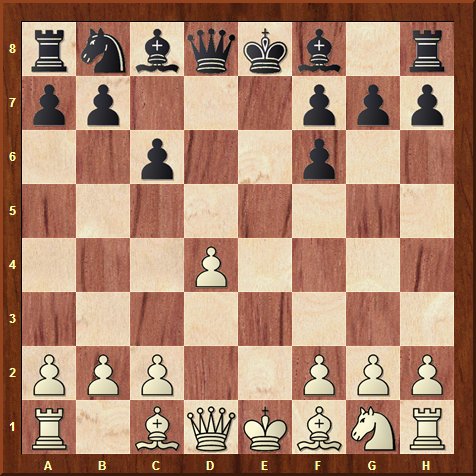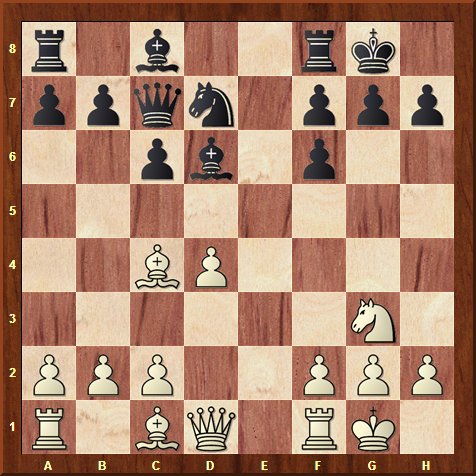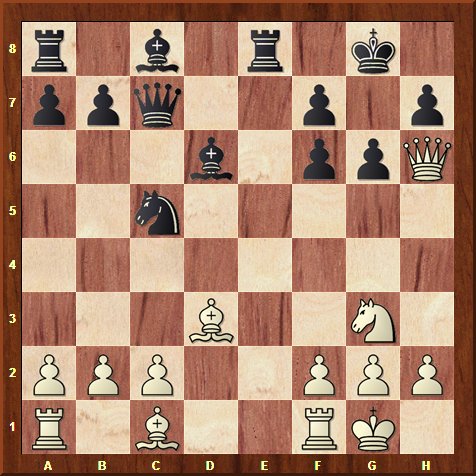All
the |
(Navigation bar
directly below.)
*******
© A.J. Goldsby, 2015.
(All rights reserved.)
****************
Click HERE
to see my
Chess Items.
****************
****************
Buy a book
from Amazon.com
(And help me out as well!)
****************
Click HERE
...
to see a list of the businesses that help to sponsor all of
my chess efforts.
"Chess Games" Problem of the DayTuesday; November 20th, 2012. |
Click HERE to see an explanation of the symbols that I commonly use when I annotate any chess game.
Click HERE
to replay this game on the "Chess Games" website.
(There are a lot of good
comments in the kibitzing section - just below the actual game,
itself.)
Click HERE to go to my YT channel. ---> Click HERE to go to "You-Tube" ... and watch my video on this game.
Andrija Fuderer (2608) -
Jan Hein Donner (2544)
|
|
|
rnbqkb1r/pp3ppp/2p2p2/8/3P4/8/PPP2PPP/R1BQKBNR w KQkq - 0 6
One of the general "rules-of-thumb"
for the opening is to always capture towards the center.
---> By violating this convention, Black seeks a quick and easy development and also he has
an extra button near his King which is handy for defense. Additionally, if White lags in his development,
Black can often dominate play via the open e-file as well.
The other main option is for Black
to play 5...g7xf6!?; which is known as the Bronstein-Larsen System ...
and leads to very complex and rather difficult play. (See the line given - just below.)
[ One possible line would be:
RR 5...gxf6!?;
6.c3 Bf5; 7.Nf3, "+/=" (center, P-structure)
when White has a solid edge. (See
games in this line.)
[See MCO-15, page # 183; columns #25-27, and all notes.] ]
6.Bc4, (center, development, lines)
By pointing his KB directly at the weakest point in Black's camp, the first player clearly signals his aggressive overall attentions.
[ An alternate line would be:
6.c3 Bd6; (center, develop.)
According to the "Power-Book," this is Black's most accurate move.
(A topical line - that I played several times
in tournaments would be this continuation:
RR 6...Be7; 7.Bd3 0-0!?; 8.Qc2
g6; 9.Ne2, "+/="
when White has a (small) solid edge in this particular position. )
7.Bd3 0-0; 8.Qc2
Re8+; 9.Ne2 g6;
10.h4, "+/=" when White is better here.
[See MCO-15, page # 183; columns # 28-30, and also all applicable notes.]
A good example of this position would have to be:
GM Lubomir Kavalek (2570) - GM Ulf Andersson (2545); [B15]
Seventh Match Game (R#7) /
Washington, DC; (USA) / 1978.
{White won a brilliant attacking game in just 31 total moves.}
]
Once more, both sides develop in a conventional manner ...
here, as compared to the game quoted (above), White castles on the King-side, rather than castling on the opposite wing.
6...Bd6; 7.Ne2 0-0; 8.0-0 Qc7; 9.Ng3, "+/=" 9...Nd7;
Both sides have (more or less) completed their development and the opening phase is (now) pretty much over.
|
|
r1b2rk1/ppqn1ppp/2pb1p2/8/2BP4/6N1/PPP2PPP/R1BQ1RK1 w - - 0 10
White probably holds a very small edge here ... the first party has a slightly better control of the central squares, a tad more space, and the better Pawn structure. [Some K+P endings could simply be just lost for Black, owing to the fact that White can make a passed Pawn on the Q-side, while Black's majority (on the King-side) is pretty much permanently crippled, because of the doubled KBP's.]
**********************************************************************************
Now White decides that now is the correct time to launch an attack on the Black King, as it is difficult for the second player to easily defend his position.
[Instead of Bd3, Fritz 13 instead prefers 11.Rd1,
"+/=" as being a small (but solid) advantage for White.]
10.Qh5!? c5; 11.Bd3 g6[];
This was pretty much forced here - for Black.
[ Black loses quickly after: </=
11...h6?; 12.Bxh6!
gxh6?;
According to the machine, this is a bad idea for Black.
(Black stops the mate after: >/= 12...Ne5[];
13.dxe5 g6; 14.exd6, "+/-" (material)
but winds up being down two minor pieces.)
13.Qg4+! Kh8; 14.Qf5!, "+/-" (It's the end of the
road.)
and Black cannot prevent White from playing Qh7# on his
next move from here. ]
12.Qh6 Re8; 13.dxc5!?, (Maybe better was: >/= Bd2 here.)
This looked nice, but may actually have been a somewhat suspect decision by the first player here.
Now with a simple move, Black could have achieved a very comfortable - and possibly a superior - game.
[ Maybe better was: >/=
13.c3 b6; "~" (unclear)
when the position was about roughly equal. ]
13...Nxc5?; (This free's the Black QB; it appears to be a natural reaction...)
This play - hitting the White LSB on d3 - looks normal ... and even good for Black.
However, this is (apparently) the losing move.
|
|
r1b1r1k1/ppq2p1p/3b1ppQ/2n5/8/3B2N1/PPP2PPP/R1B2RK1 w - - 0 14
Now we have arrived at the position for our POTD on the aforementioned website.
[ Black had to play: >/=
13...Bxg3[]; (Best/100% forced.)
14.hxg3 Nxc5; 15.Be3
Nxd3; 16.cxd3 Qd6;
"~" (unclear)
when the second player should be OK, and may even have
the slightly better overall position. (Fritz, Houdini, & Deep Shredder.)
The general rule-of-thumb is that when you being attacked, you
should exchange off as many pieces as possible. Had Black followed
this relatively simple concept, he would have not gotten smashed in
such fashion as occurred in the actual game. ]
Now White wins with a nice and a very straight-forward attack.
14.Nh5! gxh5[]; (forced)
Black has to take measure to stop the mate on g7 ... or, if he preferred, he could get mated on h7 instead.
(See the note - just below.)
The machine takes on h2 here ... and then plays "give-away" ... ... ...
[ Black also gets clobbered after:
RR 14...Bf8;
15.Nxf6+ Kh8; 16.Qxh7#.
(Checkmate.) ]
(It's not surprising that Black
loses from here, the only White piece that is not actively
participating in the attack is the QR sitting on the a1-square.)
15.Bxh7+ Kh8; 16.Bg6+ Kg8; 17.Qh7+, Black Resigns.
Donner throws in the towel, as he is about to be mated.
(I.e., 17...Kf8; 18.Bh6+, Ke7; 19.QxP/f7+, Kd8; 20.QxR/e8#.)
An interesting game and also an amusing combination ...
This is the kind of game that the aspiring chess student can learn a great deal from.
(It is also an amusing little
miniature game of chess - see my web page
for this topic.)
Copyright (c) A.J. Goldsby, 2012. All rights reserved.
1 - 0
Notable games - by higher rated players - in this line.
(1.e4,
c6; 2.d4, d5; 3.Nd2 or 3.Nc3, and now 3...dxe4; 4.NxP/e4,
Nf6; 5.NxN/f6+, exf6.)
-
A good, (solid) fair fight ... the game ends in a complicated draw - see here.
(These games/links added - Saturday; December 1st, 2012.)
The analysis for this page was
prepared with the excellent
program,
ChessBase
10.0.
(My primary engines are Fritz 12, Fritz
13, and Houdini 1.5. However, I also use Deep Shredder,
and older versions of Deep Junior and
also an older version of Hiarcs, as well.)
The HTML was polished with several different tools and programs, (mostly FP) ... the text was checked for spelling with MS Word.
|
Go ... or return ... to my Home Page for this site. Go (or return) ... to my "Annotated Games" (II) Page. Go
... or return ... to my "Best Games"
Page. *******
Copyright (c)
LM A.J. Goldsby
I *******
This page was first generated in late November, 2012. (Final
format completed / posted on Friday; November 30th, 2012.) |


